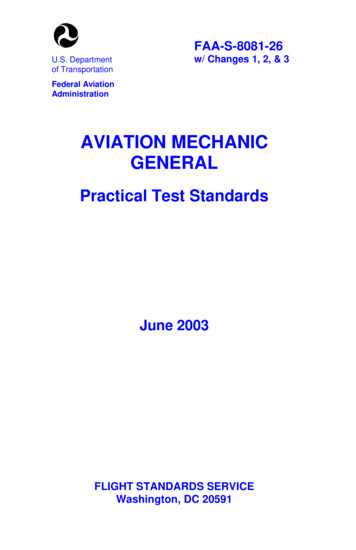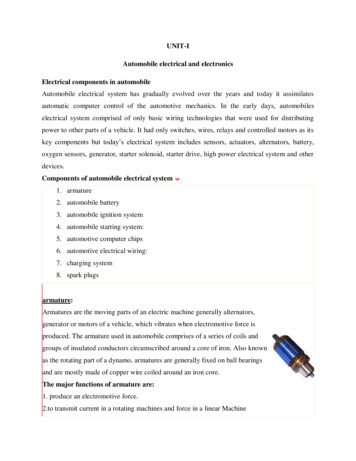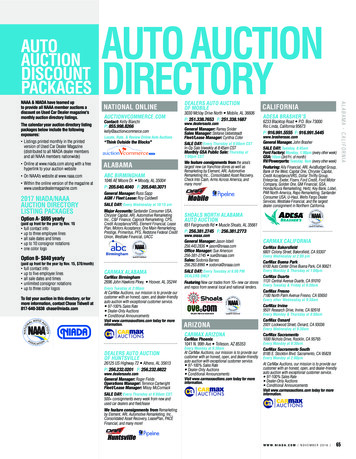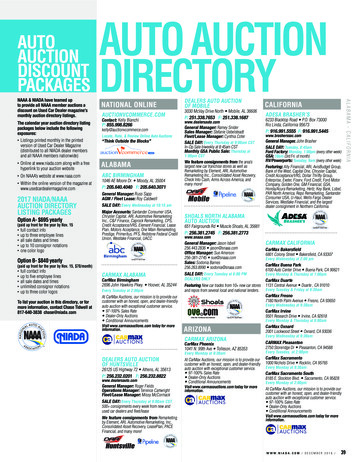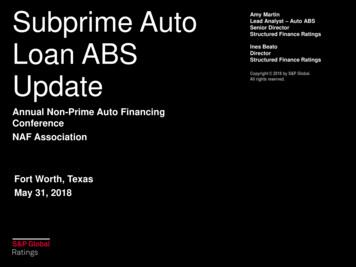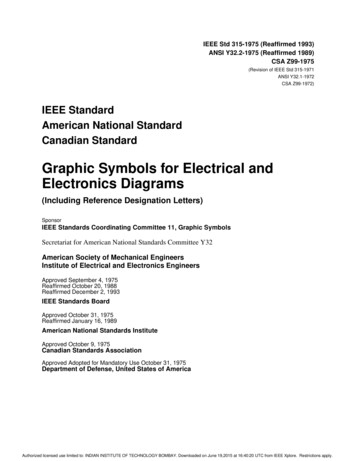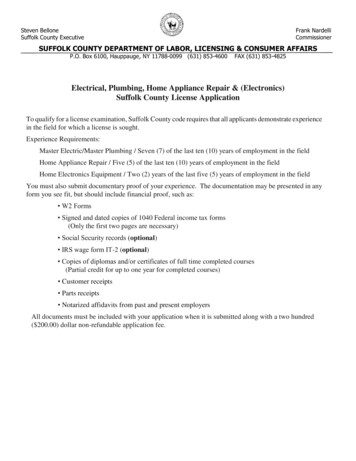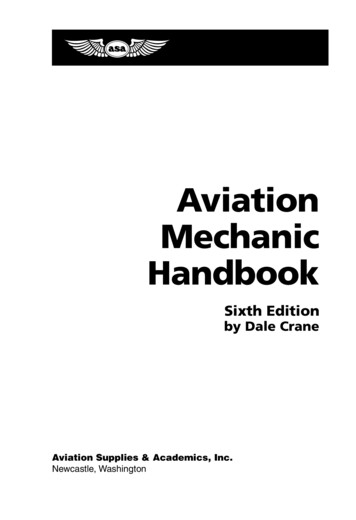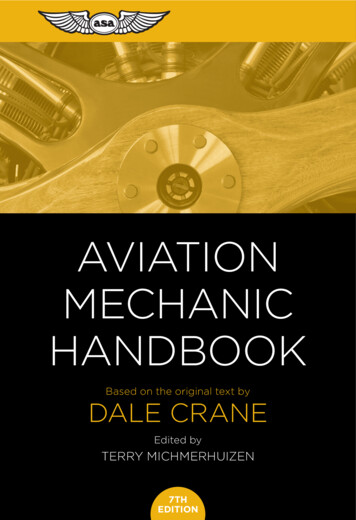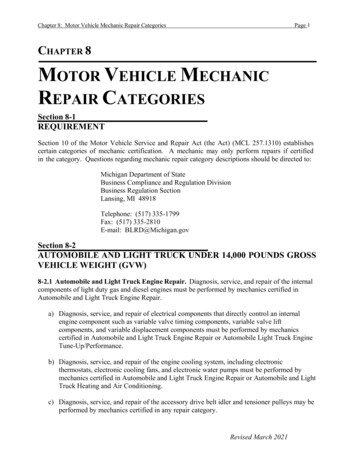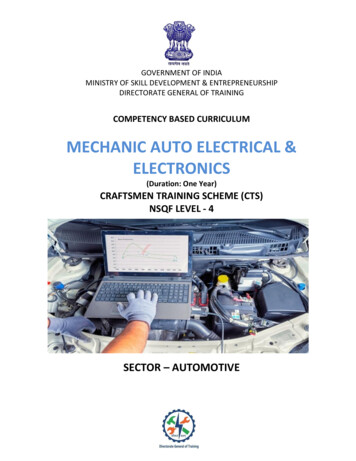
Transcription
GOVERNMENT OF INDIAMINISTRY OF SKILL DEVELOPMENT & ENTREPRENEURSHIPDIRECTORATE GENERAL OF TRAININGCOMPETENCY BASED CURRICULUMMECHANIC AUTO ELECTRICAL &ELECTRONICS(Duration: One Year)CRAFTSMEN TRAINING SCHEME (CTS)NSQF LEVEL - 4SECTOR – AUTOMOTIVE
MECHANIC AUTO ELECTRICAL &ELECTRONICS(Engineering Trade)(Revised in 2019)Version: 1.2CRAFTSMEN TRAINING SCHEME (CTS)NSQF LEVEL- 4Developed ByMinistry of Skill Development and EntrepreneurshipDirectorate General of TrainingCENTRAL STAFF TRAINING AND RESEARCH INSTITUTEEN-81, Sector-V, Salt Lake City,Kolkata – 700 091www.cstaricalcutta.gov.in
CONTENTSSNo.TopicsPage No.1.Course Information12.Training System23.Job Role64.General Information75.Learning Outcome106.Assessment Criteria117.Trade Syllabus17Annexure I(List of Trade Tools & Equipment)36Annexure II (List of Trade experts)44
Mechanic Auto Electrical & Electronics1. COURSE INFORMATIONDuring the one-year duration a candidate is trained on subjects Professional Skill,Professional Knowledge, Engineering Drawing, Workshop Calculation Science and EmployabilitySkills related to job role. In addition to this a candidate is entrusted to make/do project workand extra-curricular activities to build up confidence. The practical skills are imparted in simpleto complex manner & simultaneously theory subject is taught in the same fashion to applycognitive knowledge while executing task.The broad components covered under ProfessionalSkill subject are as below:The trainee begins with safety aspect in general and specific to the trade, identification oftools & equipment, raw materials used. The trainee will perform precision measurements onthe components and compare parameters with specifications used in automotive workshop. Helearns to carry out basic fitting operations used in the workshop practices and inspection ofdimensions.The trainee performs grinding of cutting tools and surface finishing operations inthe given job. He learns to inspect the auto component using Non-destructive testing methods,to identify the hydraulic and pneumatic components in a vehicle. Constructs electrical circuitsand performs basic electrical testing in a vehicle. Apply safe working practices and environmentregulation in an automotive workshop. He identifies the major components of LMV/HMV anddashboard gauges. Performs the wiring circuits and the electrical components in the vehicle,troubleshoots different wiring circuits in vehicle and prepare different electrical joints. Helearns to check and overhaul the ignition system, service and test battery,inspects powersteering control module and troubleshoot. He identifies and checks ABS components,troubleshoots in all electrical circuits, diagnosis for all comfort system. He also understands theconstructional features and working principles of MPFI system and different types of sensors inengine. The trainee identifies EDC components, sensors, actuators, major components of carAC,automotive lighting system and carries out repair &maintenance.1
Mechanic Auto Electrical & Electronics2. TRAINING SYSTEM2.1 GENERALThe Directorate General of Training (DGT) under Ministry of Skill Development &Entrepreneurship offers a range of vocational training courses catering to the need of differentsectors of economy/ Labour market. The vocational training programmes are delivered underthe aegis of Directorate General of Training (DGT). Craftsman Training Scheme (CTS) withvariants and Apprenticeship Training Scheme (ATS) are two pioneer schemes of DGT forstrengthening vocational training.Mechanic Auto Electrical & Electronics trade under CTS is one of the courses deliverednationwide through network of ITIs. The course is of one-year duration. It mainly consists ofDomain area and Core area. The Domain area (Trade Theory & Practical) imparts professionalskills and knowledge, while Core area (Workshop Calculation science, Engineering Drawing andEmployability Skills) imparts requisite core skills, knowledge and life skills. After passing out thetraining program, the trainee is awarded National Trade Certificate (NTC) by DGT which isrecognized worldwide.Candidates need broadly to demonstrate that they are able to: Read & interpret technical parameters/document, plan and organize work processes,identify necessary materials and tools;Perform task with due consideration to safety rules, accident prevention regulations andenvironmental protection stipulations;Apply professional skill, knowledge, core skills & employability skills while performingjobsand repair & maintenance work.Document the technical parameters related to the task undertaken.2.2 PROGRESSION PATHWAYS Can join industry as Technician and will progress further as Senior Technician, Supervisorand can rise up to the level of Manager.Can become Entrepreneur in the related field.Can join Apprenticeship programme in different types of industries leading to a NationalApprenticeship certificate (NAC).Can join Crafts Instructor Training Scheme (CITS) in the trade for becoming instructor inITIs.Can join Advanced Diploma (Vocational) courses under DGT as applicable.2
Mechanic Auto Electrical & Electronics2.3 COURSE STRUCTURETable below depicts the distribution of training hours across various course elementsduring a period of oneyear:S No.12345Course ElementProfessional Skill (Trade Practical)Professional Knowledge (Trade Theory)Workshop Calculation & ScienceEngineering DrawingEmployability SkillsTotalNotional Training Hours1000280808016016002.4 ASSESSMENT & CERTIFICATIONThe trainee will be tested for his skill, knowledge and attitude during the period ofcourse through formative assessment and at the end of the training programme throughsummative assessment as notified by the DGTfrom time to time.a) The Continuous Assessment (Internal)during the period of training will be done by FormativeAssessment Method by testing for assessment criteria listed against learning outcomes. Thetraining institute has to maintain individual trainee portfolio as detailed in assessmentguideline. The marks of internal assessment will be as per the formative assessment templateprovided on www.bharatskills.gov.inb) The final assessment will be in the form of summative assessment. The All India Trade Testfor awarding NTC will be conducted by Controller of examinations, DGT as per the guidelines.The pattern and marking structure is being notified by DGTfrom time to time. The learningoutcome and assessment criteria will be basis for setting question papers for finalassessment. The examiner during final examination will also check individual trainee’s profileas detailed in assessment guideline before giving marks for practical examination.2.4.1 PASS REGULATIONFor the purposes of determining the overall result, weightage of 100% is applied for six monthsand one year duration courses and 50% weightage is applied to each examination for two yearscourses. The minimum pass percent for Trade Practical and Formative assessment is 60% & forall other subjects is 33%. There will be no Grace marks.3
Mechanic Auto Electrical & Electronics2.4.2 ASSESSMENT GUIDELINEAppropriate arrangements should be made to ensure that there will be no artificialbarriers to assessment. The nature of special needs should be taken into account whileundertaking the assessment. Due consideration should be given while assessing for teamwork,avoidance/reduction of scrap/wastage and disposal of scrap/waste as per procedure,behavioral attitude, sensitivity to the environment and regularity in training. The sensitivitytowards OSHE and self-learning attitude are to be considered while assessing competency.Assessment will be evidence based comprising the following: Job carried out in labs/workshopRecord book/ daily diaryAnswer sheet of assessmentViva-voceProgress chartAttendance and punctualityAssignmentProject workEvidences and records of internal (Formative) assessments are to be preserved untilforthcoming examination for audit and verification by examining body. The following markingpattern to be adopted while assessing:Performance LevelEvidence(a) Weightage in the range of 60%-75% to be allotted during assessmentFor performance in this grade, the candidateshould produce work which demonstratesattainment of an acceptable standard ofcraftsmanship with occasional guidance, and dueregard for safety procedures and practices.4 Demonstration of good skill in the use ofhand tools, machine tools and workshopequipment. 60-70%accuracyachievedwhileundertaking different work with thosedemanded by the component/job. A fairly good level of neatness andconsistency in the finish. Occasional support in completing theproject/job.
Mechanic Auto Electrical & Electronics(b) Weightage in the range of 75%-90% to be allotted during assessmentFor this grade, a candidate should produce workwhich demonstrates attainment of a reasonablestandard of craftsmanship, with little guidance,and regard for safety procedures and practices Good skill levels in the use of hand tools,machine tools and workshop equipment. 70-80%accuracyachievedwhileundertaking different work with thosedemanded by the component/job. A good level of neatness and consistencyin the finish. Little support in completing theproject/job.(c) Weightage in the range of more than 90% to be allotted during assessmentFor performance in this grade, the candidate,with minimal or no support in organization andexecution and with due regard for safetyprocedures and practices, has produced workwhich demonstrates attainment of a highstandard of craftsmanship.5 High skill levels in the use of hand tools,machine tools and workshop equipment. Above 80% accuracy achieved whileundertaking different work with thosedemanded by the component/job. A high level of neatness and consistency inthe finish. Minimal or no support in completing theproject.
Mechanic Auto Electrical & Electronics3. JOB ROLEElectrician, Automobile; installs, repairs replaces and overhauls wiring, starters, generators,distributors and other electrical equipment of motor vehicles. Examines vehicle battery, checksvoltage and specific gravity using special equipment such as voltmeter hydrometer, heavydischarge tester, etc. and ensures that battery is in good condition. Checks vehicle wiring,locates faults and rectifies defects by replacing damaged wire or connecting ends withinsulation tape. Starts engine to check whether alternator is charging correctly, and ifdistributor, condenser coil and cut out are functioning properly. Estimates nature of defectsand reports components to be replaced or repaired. Dismantles and repairs electrical units andcomponents such as generator, distributor etc. where required. Replaces repaired kit or unit invehicle and connects it with battery. Conducts thorough examination of various electricalfittings such as lights, panel indicators, fuel pumps, etc. and rectifies defects. Checks conditionand makes necessary adjustments. May do armature winding. May drive vehicles on road. Maycharge batteries.Reference NCO-2015:(i)7412.0701- Electrician, Automobile6
Mechanic Auto Electrical & Electronics4. GENERAL INFORMATIONName of the TradeMechanic Auto Electrical & ElectronicsTrade CodeDGT/1124NCO - 20157412.0701NSQF LevelLevel – 4Duration of CraftsmenTrainingOne year (1600 Hours)Entry QualificationPassed 10th class examination with Science and Mathematics orits equivalent.Minimum Age14 years as on first day of academic session.Eligibility for PwDLD, LC, DW, AA, LV, DEAFUnit Strength (No. Of Student) 20 (There is no separate provision of supernumerary seats)Space norms100 Sq. m (Including parking area)Power norms3 KWInstructors Qualification for:1. Mechanic Auto Electrical & B.Voc/Degree in Automobile/ Mechanical Engineering/ ElectricalElectronics cialization in Automobile) from AICTE / UGC recognizedEngineering College/ university with one-year experience in therelevant field.OR03 years Diploma in Automobile/ Mechanical / ElectricalEngineering / Electronics & communication Engineering (withspecialization in automobile) from AICTE/recognized board oftechnical education or relevant Advanced Diploma (Vocational)from DGT with two years’ experience in the relevant field.ORNTC/NAC passed in the trade of "Mechanic Auto Electrical &Electronics"/ “Mechanic Motor Vehicle” with three years’experience in the relevant field.Essential Qualification:Relevant National Craft Instructor Certificate (NCIC) in any of the7
Mechanic Auto Electrical & Electronicsvariants under DGT.2. Workshop Calculation &ScienceNOTE: - Out of two Instructors required for the unit of 2(1 1),one must have Degree/Diploma and other must have NTC/NACqualifications. However, both of them must possess NCIC inany of its variants.B.Voc/Degree in Engineering from AICTE/UGC recognizedEngineering College/ university with one-year experience in therelevant field.OR03 years Diploma in Engineering from AICTE /recognized boardof technical education or relevant Advanced Diploma(Vocational) from DGT with two years’ experience in therelevant field.ORNTC/ NAC in any one of the engineering trades with three years’experience.Essential Qualification:National Craft Instructor Certificate (NCIC) in relevant tradeORNCIC in RoDA or any of its variants under DGT3. Engineering DrawingB.Voc/Degree in Engineering from AICTE/UGC recognizedEngineering College/ university with one-year experience in therelevant field.OR03 years Diploma in Engineering from AICTE /recognized boardof technical education or relevant Advanced Diploma(Vocational) from DGT with two years’ experience in therelevant field.ORNTC/ NAC in any one of the Electrical trades categorized underEngg. Drawing’/ D’man Mechanical / D’man Civil’ with threeyears’ experience.Essential Qualification:National Craft Instructor Certificate (NCIC) in relevant tradeORNCIC in RoDA / D’man (Mech /civil) or any of its variants underDGT.8
Mechanic Auto Electrical & Electronics4. Employability SkillMBA/ BBA / Any Graduate/ Diploma in any discipline with Twoyears’ experience with short term ToT Course in EmployabilitySkills from DGT institutes.(Must have studied English/ Communication Skills and BasicComputer at 12th / Diploma level and above)ORExisting Social Studies Instructors in ITIs with short term ToTCourse in Employability Skills from DGT institutes.5. Minimum Age for Instructor 21 YearsList of Tools and EquipmentAs per Annexure – IDistribution of training on Hourly basis: (Indicative only)Total Hrs/weekTradePracticalTrade TheoryWorkshop Cal.& Sc.Engg.DrawingEmployabilitySkills40 Hours25 Hours7 Hours2 Hours2 Hours4 Hours9
Mechanic Auto Electrical & Electronics5. LEARNING OUTCOMELearning outcomes are a reflection of total competencies of a trainee and assessmentwill be carried out as per the assessment criteria.5.1LEARNING OUTCOMES (TRADE .18.19.20.21.22.Use different types of tools and work shop equipment in the Auto work shopfollowingsafety precautions.Perform precision measurements on the components and compare parameters withspecifications used in automotive work shop practices.Use of different type of fastening and locking devices in a vehicle.Perform basic fitting operations used in the work shop practices and inspection ofdimensions.Produce components using bending process in the given work piece.Construct electrical circuits and test its parameters by using electrical measuringinstruments.Perform basic electrical testing in a vehicle.Perform battery testing and charging operations.Construct basic electronic circuits and testing.Manufacture components with different types of welding processes in the given job.Identify the hydraulic and pneumatic components in a vehicle.Check & Interpret Vehicle Specification data and VIN, Select & operate various ServiceStation Equipments.Identify the major components of LMV/HMV and dashboard gauges.Identify and Checkwiring circuits and the electrical components in the vehicle.Trace /troubleshoot different wiring circuits in vehicle and prepare different electricaljoints.Check and overhaul the ignition system.Apply appropriate rule and tools for starting and charging system and diagnose &rectify faults.Understand the constructional features and working principles of EDC/MPFI system.Inspect power steering control module and troubleshoot in power steering.Diagnosis for all comfort system.Demonstrate the skill of automotive lighting system and their troubleshooting.Troubleshoots in all electrical circuits.10
Mechanic Auto Electrical & Electronics6. ASSESSMENT CRITERIALEARNING OUTCOMESASSESSMENT CRITERIA1.Use different types oftools and work shopequipment in the Autowork shop followingsafety precautions.Identify the different types of hand and power tools used in theautomotive work shop.Operate various tools and work shop equipment.2.Perform precisionmeasurements on thecomponents andcompare parameterswith specifications usedin automotive work shoppractices.Measure all dimensions in accordance with standard specificationsand tolerances by using precision measuring instruments.Measure the parameters related with the vehicle components forits effective operation by matching with manufacturer'sspecification using different gauges3.Use of different type offastening and lockingdevices in a vehicle.Identify the different type of fasteners and locking devices used inthe vehicle.Use different types of locking devices correctly.Specify the bolt and nut threads.Practice on removing the damaged studs and bolts.4.Perform basic fittingoperations used in thework shop practices andinspection ofdimensions.Mark according to drawing by using marking tools on flat surfaces.Hack saw and file the job using different methods and perform inaccordance with the standard specifications and tolerances.Drilling and reaming on flat surfaces.Identify and use hand tools for internal and external threading withtaps and dies.Measure all dimensions in accordance with standard specificationand tolerances.5.Produce componentsusing bending process inthe given work piece.Ascertain and select tools, equipment and materials for thejob and make this available for use in a timely manner.Plan and organize the work for pipe bending operations.Perform bending, soldering and brazing operations in accordancewith standard operating procedure using appropriate tools.11
Mechanic Auto Electrical & ElectronicsCheck accuracy/correctness of the job using appropriate measuringinstruments.6.Construct electricalcircuits and test itsparameters by usingelectrical measuringinstruments.Plan and organize the work for basic electrical operations.Select the tools, instruments and materials required to do the job.Comply with safety rules when performing the basic electricaloperations.Perform electrical wire joints, form electrical circuits and test basicelectrical parameters as per the circuit drawings and operatingprocedures.7.Perform basicelectricaltesting in avehicle.Plan and organize the work for auto electrical componenttesting.Tracing the auto electrical components in a vehicle.Test continuity and voltage drop in the electrical circuits.Operate the electrical components in a vehicle and testlamps.8.Perform battery testingand charging operations.Ascertain and select tools and materials for the job.Comply with safety rules when performing the followingoperations.Plan and select different methods for charging the battery.Perform battery testing as per the operating procedure.9.Construct basicelectronic circuits andtesting.Plan and select different types of basic electronic components andmeasuring instruments.Construct and test the basic electronic gate circuits and itscomponents as per the standard procedure.10. Manufacturecomponents withdifferent types ofwelding processes in thegiven job.Plan and select appropriate method to produce componentswith welding process.Comply with safety rules when performing the aboveoperations.Mark according to the drawing using marking tools on thejob.Select appropriate tools and equipment to perform the aboveoperations.Set up and produce component as per standard operatingprocedure.12
Mechanic Auto Electrical & Electronics11. Identify the hydraulicand pneumaticcomponents in a vehicle.Comply with safety rules when performing the followingoperations.Locate and identify the hydraulic components in a vehicle.Locate and identify the pneumatic components in a vehicle.12. Check & InterpretVehicle Specificationdata and VIN, Select &operate various ServiceStation EquipmentsIdentify of different type of vehicle.Identify the different vehicle specification data and informationDemonstrate the garage, service station different equipment13. Identify the majorAscertain and select tools and materials for the job and make thiscomponents of LMV/HMV available for use in a timely manner.and dashboard gauges.Plan work in compliance with standard safety norms.Identify the parts of Diesel/Petrol engine.Identify different gauges fitted on the dashboard and check forproper functioning.Perform daily checks before starting the engine.Start the engine and allow it to warm up.Identify the problem in functionality of particular Gauge fitted ondashboard and record the reading and compare it with standardreading.Repair / Replace the defective gauges as per standard operatingpracticeCheck for proper functionality.Stop the engineComply with safety rules when performing the abovejobs.14. Identify and Checkwiringcircuits and the electricalcomponents in thevehicle.Ascertain and select tools and materials for the job and make thisavailable for use in a timely manner.Plan work in compliance with standard safety norms.Identify Personal Protective Equipment and use the sameas per related working environment.Locate and identify the electrical components in a vehicleby using wiring diagram.13
Mechanic Auto Electrical & ElectronicsLocate and identify the power sources of various controls ofelectrical circuits.15. Trace /troubleshootdifferent wiring circuitsin vehicle and preparedifferent electrical joints.Diagnosis and remedy for-Speedometer shows no operation., ,Diagnosis and remedy for fuel level meter shows no operationDiagnosis and remedy for coolanttempmeter shows nooperationDiagnosis and remedy for Oil pressure light shows no lighting16. Check and overhaul theignition system.Ascertain and select tools and materials for the job and makethis available for use in a timely manner.Identify Personal Protective Equipment and use the same as perrelated working environment.Plan and organize work for overhaul the ignition system.Check all components of ignition system physically, electrically andreplace if required.Diagnosis the possible causes for hard or no start of enginerelated to ignition system.Diagnosis the possible causes for hard or no start of enginerelated to fuel system.17. Apply appropriate rule andCheck Charging system for proper functioning as permanufacturer guidelines.Check alternator for proper functioningRemove alternator from the vehicleOverhaul and check alternator for proper functionRefit Alternator to the vehicle and check for functioningCheck starting system for proper functioning as per manufacturerguidelines.Check starter for proper functioningRemove starter from the vehicle.Overhaul and check starter for proper functionRefit starter to the vehicle and check for functioningtools for starting andcharging system anddiagnose & rectify faults.18. Understand theconstructional featuresand working principlesIdentify EDC components/ sensors,Test sensors /actuators.Identify various components of MPFI system.14
Mechanic Auto Electrical & Electronicsof EDC/MPFI system.Test MPFI components and replace if necessary.Check delivery from fuel Pump.Replace fuel filter.Fault finding in Electronic circuit and remedies using scan tool.19. Inspect power steeringcontrol module andtroubleshoot in powersteering.Ascertain and select tools and materials for the job and make thisavailable for use in a timely manner.Plan and organize work for overhaul the starting system with safetynorms.Check power steering and its components for proper functioning.Flush power steering.Check fluid and fluid pressure of power steering circuit.Diagnosis and trouble for power steering system.20. Diagnosis for all comfortsystem.Ascertain and select tools and materials for the job and make thisavailable for use in a timely manner.Plan and organize work to check the components of automatictransmission system with safety norms.Identify and locate the components of Carr AC system in a givenvehicle.Check charge state of refrigerant.Check AC system and its components for proper functioning.Check and replace/adjust compressor belt tension.Carry out the diagnostic procedure for the following trouble.No cooling.Intermittent cooling.Insufficient cooling.Abnormal noise from compressor, magnetic clutch, condenser,evaporator, and blower.High pressure gauge—Pressure high and low.Low pressure gauge Pressure high and low.21. Demonstrate the skill ofAscertain and select tools and materials for the job and make thisautomotive lighting system available for use in a timely manner.and their troubleshooting. Plan and organize work to check the components of lighting circuit.Read the wiring circuit of lighting of the given vehicle.Operate and check the function of combination switch and15
Mechanic Auto Electrical & Electronicsother light switches.Check the lights whether glow or not.Replace the defective bulbs/fuse/faulty wire/electrical or electroniccomponents.Check fluid level light, engine oil pressure light, brake warning light.Align head light for proper focus.Repair and rectify any other faults in the light circuit.22. Trouble shoots in allelectrical circuits.Ascertain and select tools and materials for the job and make thisavailable for use in a timely manner.Plan and organize work to check the components of lighting circuit.Carry out the diagnostic procedure for the following troubles in theimproper functioning electrical accessories.a) Improper functioning of horn.b) Improper functioning of wiper and washer circuit.c) Improper functioning of power window.d) Improper functioning of flasher circuit.e) Improper functioning of immobilizer system.f) Improper functioning of seat belt circuit.g) Improper functioning of air bag system.h) Improper functioning of car radio wiring.16
Mechanic Auto Electrical & Electronics7. TRADE SYLLABUSSYLLABUS – MECHANIC AUTO ELECTRICAL & ELECTRONICSDuration: One YearDurationProfessionalSkill 125Hrs;ProfessionalKnowledge35HrsReference LearningOutcomeUse different typesof tools and workshop equipment inthe Auto work ional Skills(Trade Practical)With Indicative HoursFamiliarizationwithinstitute, Job opportunitiesin the automobile sector,Machinery used in Trade.(10hrs)Types of work done by thestudents in the shop floor.(15 hrs)Practical related to Safetyand Health,Importance ofmaintenance and cleanlinessof Workshop. (08 hrs)Interaction with healthcentre and fire servicestation to provide demo onFirst aid and Fire safety, Useof fire extinguishers.(07 hrs)Demonstration on safehandlingandPeriodictesting of lifting equipment,and Safety disposal of Usedengine oil.(08 hrs)Energy saving Tips of ITIelectricity Usage.(02 hrs)17Professional Knowledge(Trade Theory)Admission & introduction tothe trade: Introduction to theCourseduration,coursecontent, study of the syllabus.General rule pertaining to theInstitute, facilities availableHostel, Recreation, Medicaland Library working hours andtime table.(07hrs)Occupational Safety & HealthImportanceof Safety andgeneral Precautions to beobserved in the shop. Basic firstaid, safety signs - for Danger,Warning, caution & personalsafety message. Safe handlingofFuelSpillage,Fireextinguishers used for differenttypes of fire. Safe disposal oftoxic dust, safe handling andPeriodic testing of liftingequipment, Authorization ofMoving &road testing vehicles.Energy ities(ECOs)-MinorECOs and Medium ECOs, MajorECOs), Safety disposal of Usedengine oil, Electrical safety tips.
Mechanic Auto Electrical & Electronics7.Practice using all markingaids, likesteel rule withspring calipers, dividers,scriber, punches, Chiseletc.,Layout a work piece- forline, circle, arcs andcircles.(40hrs)8. Practice to measure a wheelbase of a vehicle withmeasuring tape.(12hrs)9. Practice to measure valvespring tension using springtension tester.(08hrs)10. Practice to remove wheellug nuts with use of an airimpact wrench Practice onGeneral workshop tools &power tools.(15hrs)ProfessionalSkill 50 Hrs;Perform precision 11. Measuring practice on Cammeasurements onheight, Camshaft Journal18(07hrs)Hand & Power Tools:Marking scheme, Markingmaterial-chalk, Prussian blue.Cleaning tools- Scraper, wirebrush,Emerypaper,Description, care and use ofSurface plates, steel rule,measuring tape, try square.Calipers-inside and outside.Dividers,surfacegauges,scriber, punches-prick punch,center punch, pin punch,hollow punch, number andletter punch. Chisel-flat, crosscut. Hammer- ball pein, lump,mallet. Screw drivers-bladescrewdriver, Phillips screwdriver, Ratchet screwdriver.Allen key, bench vice & Cclamps,Spannersringspanner, open end spanner &the combination spanner,universal adjustable open endspanner. Sockets & accessories,Pliers - Combination pliers,multi grip, long nose, flat-nose,Nippers or pincer pliers, Sidecutters, Tin snips, Circlip pliers,external circlips pliers. Airimpact wrench, air ratchet,wrenches- Torque wrenches,pipe wrenches, car jet washersPipe flaring & cutting tool,pullers-Gear and bearing.(21hrs)Systems of measurement,Description, care & use of -
Mechanic Auto Electrical & ElectronicsProfessionalKnowledge14 ions usedin automotive workshop practices.12.13.14.15
the components and compare parameters with specifications used in automotive workshop. He learns to carry out basic fitting operations used in the workshop practices and inspection of di
